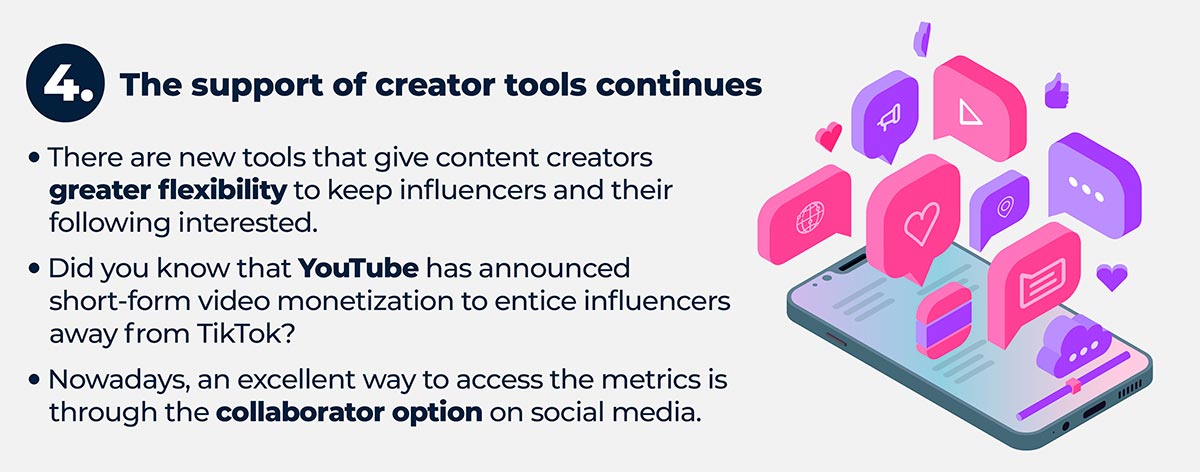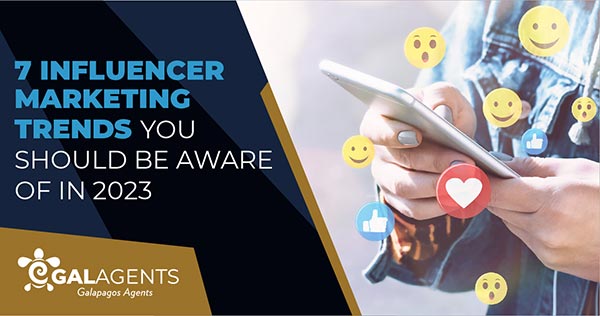In a digital native era, influencers are the king and queens. They have built a bridge with people by using their “authenticity.” Thanks to that connection and the online platform measuring tools, they can prove their engagement level and impact on their audiences.
Therefore, influencer marketing is a vital marketing tool nowadays, so we should have a social media strategy adapted to our needs and objectives. Then, according to Forbes, there are seven trends we should consider in 2023, which we will discuss below.
1- Authenticity is more valuable than ever
Digital natives can quickly identify sales pitches online. They ignore advertisements but follow the influencers whom they connect with on a genuine level.

It’s not a surprise that, nowadays, the most popular platforms are the ones that showcase genuine content. For example, as Forbes predicted, TikTok surged in 2022 and continues to show high engagement rates because creators upload creative, fascinating content that isn’t heavily branded. In addition, its users value sharing truthful, uncensored information. BeReal, on the other hand, entered the market and topped the Google Play best apps list last year.
2- Reuse influencers’ content and maximize collaborations
Influencers can produce more professional material and become effective in social media. Because of this, more companies are likely to work close to influencers and reuse the material they produce.

Indeed, some companies go one step further and hire influencers on their internal teams. But it’s optional; as organizations, we can and will find methods to reuse the content produced through our creator agreements to maximize the return on our influencer marketing spending.
3- Ready to research and jump into the Web 3.0 and Metaverse worlds?
After the boom of the metaverse, more businesses began to investigate it and think about their possibilities to enter it. Yet, building areas within the metaverse can be expensive and need additional regulatory hoops to jump through. Hence, using influencer marketing offers us a practical way to test these virtual waters at a cheaper cost.

Followers often want a deeper, more interactive interaction with the influencers they follow. Thus, metaverse might be an excellent fit for content creators and their fans. Then, it can be a great opportunity for us too.
For example, in the tourism industry, the epicurean traveler can showcase the real experiences that everyone can have in a destination or tourist attraction, helping us raise awareness among specific audiences.
4- The support of creator tools continues
More than just platform users are creators. They foster engagement and use it to fuel the platform’s success. Media have revealed new tools that give content creators greater flexibility to keep influencers and their following interested.

For instance, platforms are investing in solutions to keep creators motivated and engaged because they recognize the value that influencers produce.
Did you know that YouTube has announced short-form video monetization to entice influencers away from TikTok? Instagram and TikTok, on the other hand, are now offering subscription services.
As brands, we are no different. We are looking for collaborative content tools to boost engagement. One tangible example of profiting from connections with influencers is Walmart. The giant retailer has introduced Walmart Creator as a tool to reward creators for featuring their work and earning commissions. At the same time, Walmart will get more access to metrics and data regarding influencer marketing strategies. As they compete for the attention of content creators, more notable brands are likely to take a similar approach.
In the meantime, an excellent way we have to access the metrics is through the collaborator option, which allows us to check the numbers each influencer post about us is getting.
5- There’s a bigger eye on sponsored content
Creators are under scrutiny by platforms and followers to ensure the genuine impact they have on their viewers. Therefore, paid posts must include the hashtags #Ad or #Sponsored, and enforcement efforts have recently increased.

Brands and influencers’ collaborations need to manage the content development, review, and approval processes by the regulatory environment in their respective industries.
We want to avoid what happened to Kim Kardashian, who was recently fined $1 million for failing to disclose in an Instagram post that she had received $225,000 in exchange for endorsing the cryptocurrency EthereumMax.
6- Specializing in niches is the key
Content producers and influencers have been constantly advised to find their expertise. Why? Niches will likely grow even more specialized due to viewers’ seemingly insatiable appetite for technical material.

When planning niche content, it’s essential to balance authenticity and intrusiveness. With relation to the idea of authenticity, customers may feel spied on or question the sincerity of the influencer engagement if the material is very hyper-targeted.
7- Instagram remains the leader, but other networks are creatively standing out
Influencer marketing and brand collaborations on Instagram are still quite popular. The platform is generating innovative, exciting material, though, is TikTok. So, while also looking at what’s effective elsewhere, we should continue to invest in our relationships with Instagram influencers. Then, we can choose whether to use those platforms or adapt the ideas to their current ones.

We must use social media as a way to communicate with consumers. Influencer collaborations act as a go-between for our brands and customers, fostering a genuine connection that is impossible to achieve through conventional one-way marketing.
2023 anticipates seeing the impact of these alliances increase as brands eagerly take advantage of all influencers can provide, including relevance, connection, reach, and authentic marketing partnership.
Download the infographics here

